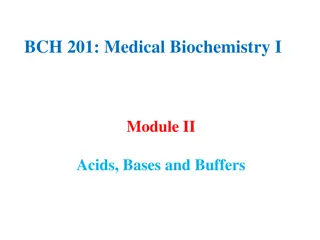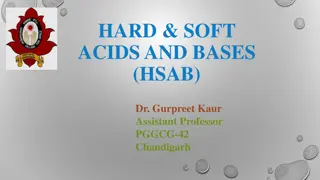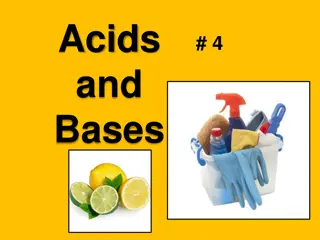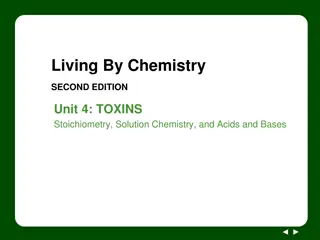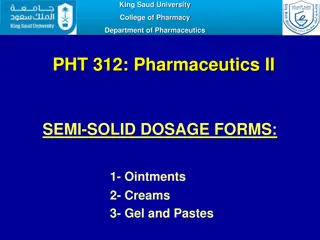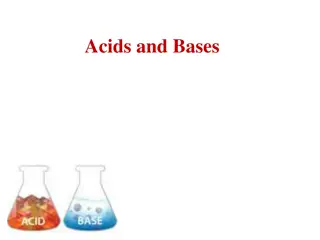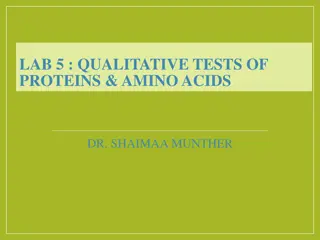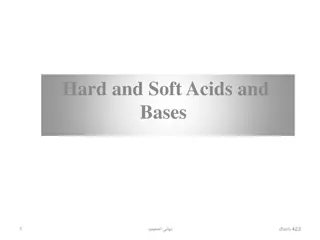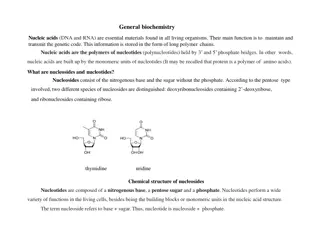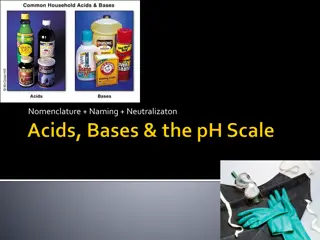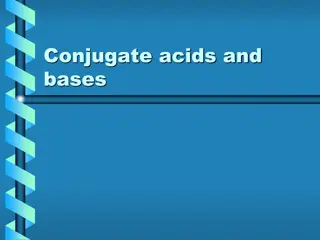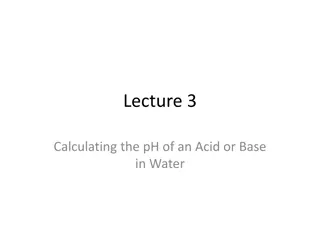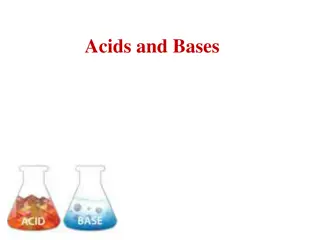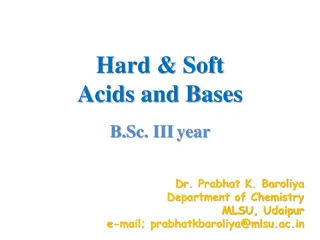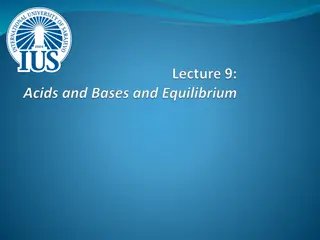
Understanding Solubility: Types, Factors, and Curves
Explore the various aspects of solubility, including terminology, types of solutions, factors affecting the rate of dissolving, and using solubility graphs to determine saturation levels. Learn about unsaturated, saturated, and super-saturated solutions, concentration measurements, and the impact of agitation, temperature, and particle size on dissolution rates. Discover how gas dissolution differs through factors like agitation, pressure, and temperature adjustments.
Download Presentation

Please find below an Image/Link to download the presentation.
The content on the website is provided AS IS for your information and personal use only. It may not be sold, licensed, or shared on other websites without obtaining consent from the author. If you encounter any issues during the download, it is possible that the publisher has removed the file from their server.
You are allowed to download the files provided on this website for personal or commercial use, subject to the condition that they are used lawfully. All files are the property of their respective owners.
The content on the website is provided AS IS for your information and personal use only. It may not be sold, licensed, or shared on other websites without obtaining consent from the author.
E N D
Presentation Transcript
Unit 9 Solutions 1
Solubility Terminology When a solution can have solute added and dissolved, the solution is unsaturated. Example: Lemonade with no or little sugar When a solution cannot have solute added and dissolved, the solution is saturated Example: Lemonade with perfect amount of sugar Super saturated solution is when a solution that contains more of the dissolved material than could be dissolved by the solvent under normal circumstances. Can have some of the solute fall out of the solution and form crystals Examples: Lemonade with solid sugar left at the bottom of the picture.
Types of solutions Concentration of a solution is a measure of the amount of solute that is dissolved in a given quantity of solvent. Solute substance being dissolved Solvent substance doing the dissolving Lemonade solution, solute is lemon juice and sugar, solvent is water. Dilute solution is on that contains a small amount of solute Concentrated solution contains a large amount of solute 1 g NaCl per 100 g H2O would be dilute when compared to 30 g NaCl per 100 g H2O (a concentrated solution) 3
Factors that affect rate of dissolving Three factors affect the rate that a solid substance will dissolve in a liquid solvent Agitation, temperature and particle size Agitation or stirring a solution will make the crystals dissolve more quickly increasing the temperature will increase the rate at which the substance will dissolve. Smaller particles (more surface area) dissolve much quicker. Remember: crush it, heat it, stir it
Factors that affect rate of dissolving Three factors affect the rate that a Gas substance will dissolve in a liquid solvent Agitation, pressure and temperature gasses dissolved in a liquid decreasing the temperature will allow an increase in the amount of gasses that can be dissolved Also increasing the pressure will increase the amount of gas that can dissolve in a liquid. NOT agitating (no stirring or shaking) will increase the amount of gas a liquid can hold.
Solubility Curve and Table A solubility graph like the one shown above is a graph where the lines graphed are representative of the solubility of various compounds. can use these graphs to find the solubility of an element at certain temperatures in one hundred grams of water. can also use it to determine if a solution is unsaturated, saturated, or super-saturated
Reading Solubility Charts If the number in the problem is EQUAL to the value on the chart/graph the solution is considered SATURATED If the number in the problem is LESS than the value on the chart/graph the solution is considered UNSATURATED If the number in the problem is MORE than the value on the chart/graph the solution is considered SUPER SATURATED Most charts/graphs are based on 100 g water. If water is doubled or tripled than the amount of salt is doubled or tripled
Reading Solubility Charts Classify each as saturated, unsaturated or super saturated 40 g NaCl at 60 C Above line = super saturated 10 g KClO3 at 30 C On line = saturated 51 g KCl at 90 C Below line = unsaturated 80 g NaNO3 at 10 C On line = saturated 80 g CaCl2 at 20 C Above line = super saturated
Reading Solubility Charts How many grams of NaCl would be needed to make a saturated solution with 200 g of water at 40 C 36 g NaCl per 100 g water. So 72 g NaCl for 200 g water What mass of water would be necessary to make a saturated solution containing 15 g KClO3 at 70 C 30 g KClO3 per 100 g water. 15 g ONLY needs 50 g water. What is the maximum temperature where a 45g KCl solution in 100 g water would be considered supersaturated? Approx. 60 C is saturated point. So 59 C it would be super saturated
Molarity Molarity (M) is the number of moles of solute dissolved in one liter of solution A measurement of the concentration of solute to solvent in a solution. To calculate the molarity of a solution, divide the moles of solute by the volume of the solution. Molarity is also known as molar concentration 10
Molarity Recall that 1 mole = molar mass g 1 Liter = 1000 mL You may have to convert amounts given in the problem to a useable unit or rearrange the equation ?????? ???????? = ????? ????? ?????? = ???????? (?) 11
Molarity Example 1 A saline solution contains 0.95 g NaCl in exactly 100 mL of solution. What is the molarity of the solution? Need moles of solute, so turn grams to moles 0.95 g NaCl x _________ = 0.016 mol NaCl Need liters of solution 100 ml x ______ = 0.100 L Molarity = = 0.16 M NaCl 12
Molarity Example 2 A solution has a volume of 2.50 L and contains 159g NaCl. What is the molarity of the solution? Need moles of solute, so turn grams to moles 0159 g NaCl x _________ = 2.72 mol NaCl Molarity = = 1.09 M NaCl 13
Molarity Example 3 What mass of NaCl is needed to make a 2.25 M NaCl solution with a volume of 500 mL? Need liters of solution 500 ml x ______ = 0.500 L Molarity x Liters = moles 2.25 M NaCl x 0.500 L = 1.13 mol NaCl Turn mole to grams 1.13 mol NaCl x = 66.0 g NaCl 14
Molarity Example 4 What volume in mililiters of solution is needed to make a 0.250 M with 86.4 g Na2SO4? Turn grams to moles 86.4?Na2SO41mole Na2SO4 142.05g Na2SO4 Use molarity and moles to find volume L = M x mole = 0.250 M x 0.608 mole = 0.152 L Convert volume from L to mL 0.152 ? 1000 ?? 1 ? =0.608 mole Na2SO4 = 152 ?? 15
Unit 10 Acids, Bases, and Salts Chapter 19 16
19.1 Acid- Base Theories Properties of Acids Taste sour React with metals to form H2 gas Turns blue litmus paper RED Properties of Bases Taste bitter feel slippery Turns red litmus paper BLUE BOTH Can be strong or weak electrolytes in aqueous solutions React with the other to produce salt (an ionic compound) and water Are corrosive Change the color of indicators 17
Examples Acid: citric acid Base: milk of magnesia Magnesium hydroxide 18
Types of acids Monoprotic acids are acids that contain one ionizable hydrogen. Nitric acid: HNO3 Diprotic acids are acids that contain two ionizable hydrogens. Sulfuric acid: H2SO4 Triprotic acids are acids that contain three ionizable hydrogens. Phosphoric acid: H3PO4 19
Arrhenius Acids and Bases Svante Arrhenius in1887 posed a way of defining acids and bases Arrhenius Acids Are hydrogen-containing compounds that ionize to yield hydrogen ions (H+) [H+ producer] HCl + H2O H3O++ Cl Arrhenius Bases Are compounds that ionize to yield hydroxide ions (OH-) in aqueous solutions. [OH- producer] NH3+ H2O NH4++ OH Arrhenius definiton incoporates the FEWEST number of compunds 20
Brnsted-Lowry Acids and Bases In 1923 Johannes Br nsted and Thomas Lowry proposed a new definition Is a more comprehensive definition of acids and bases Br nsted-Lowry Acids Is a hydrogen-ion donor Br nsted-Lowry Bases Is a hydrogen-ion acceptor 21
Lewis Acids and Bases Gilbert Lewis s theory of acids and bases was an extension of his concept of electron pairs This is the broadest acid/base definition used. Lewis acids accepts a pair of electrons Lewis bases donate a pair of electrons Acid Base 22
Acid-Base Definitions Type Acid Base Arrhenius (smallest definition) OH- producer H+ producer H+ donor H+ acceptor Br nsted-Lowry Electron-pair acceptor Lewis (broadest definition) Electron pair donor 23
4-20-17 Opener Acids Bases Contain Most start w/ Hydrogen Most end with OH pH Below 7 Above 7 taste Sour Bitter Feel Wet (like water) Slippery Turn litmus paper Red Blue Example Citric acid (lemons) HCl stomach acid Ammonia Bleach Ca(OH)2 Properties of both 1. Are weak or strong electrolytes 2. Are corrosive 3. Change the color of indicators 4. React with the other to produce salt (ionic compound) and water 24
Conjugate Acids and Bases Conjugate acid is the particle formed when a base gains a hydrogen ion. Conjugate base is the particle formed when an acid has donated a hydrogen ion. Conjugate acid-base pair consists of two substance related by the loss or gain of a single hydrogen ion. When a water molecule gains a hydrogen ion it becomes a positively charged hydronium ion (H3O+). When water molecule looses a hydrogn ion it becomes the negativly charged hydroxide ion (OH-1) 25
Conjugate Acid and Bases HCl + H2O H3O+ + Cl Acid + Base Conjugate + Conjugate Acid Base + H2O NH4++ OH NH3 Base + Acid Conjugate + Conjugate Acid Base A substance that can act as both an acid and a base is said to be amphoteric. (example: Water ) 26
Conjugate acids and base When an acid forms a conjugate base the formula changes by Subtracting an H and adding -1 charge Example: HCl and Cl When a base forms a conjugate acid the formula changes by Adding an H and adding +1 charge Example: NH3and NH4+1 Water can be both an acid or a base depending on what is added Acid: H2O to the conjugate base: OH Base: H2O to the conjugate acid: H3O+ 27
Conjugate acids and base What are the conjugate bases of these acids? a) HClO4 b) HSO4 1 c) HC2H3O2 d) H2S a) ClO4 1 b) SO4 2 c) C2H3O2 1 d) HS 1 a) SO4 2 b) NH3 c) F 1 d) HPO3 2 a) HSO4 1 b) NH4+1 c) HF d) H2PO3-1 What are the conjugate acids of these bases 28
Conjugate Acid-Base Pairs Practice 1. HCl + NH3 NH4+1 + Cl 1 acid base c. acid c. base 2. OH 1+ HCN H2O + CN 1 base acid c. acid c. base 3. PO4 3 + HNO3 NO3 1 + HPO4 2 base acid c. base c. acid 4. HCO3 1 + HCl H2CO3 + Cl 1 base acid c. acid c. base 12.HClO3 + OH- H2O + ClO3- acid bade c. acid c. base 29
19.1 Review 1. What are the properties of acids and bases? 2. How did Arrhenius define and acid and base? 3. How are acids and bases defined by the Br nsted-Lowry theory? 4. What is the Lewis-theory of acids and bases? 5. Identify the following as monoprotic, diprotic or triprotic: a) H2CO3 b) H3PO4 c) HCl d) H2SO4 30
19.1 Review 1. See slide #25 (opener from 4/20) 2. Arrhenius acid produced H+, base produced OH- 3. Br nsted-Lowry acid H+ donor, base H+ acceptor 4. Lewis-theory of acids electron pair acceptor, base is electron pair donor. 5. Identify the following as monoprotic, diprotic or triprotic: a) H2CO3 b) H3PO4 c) HCl d) H2SO4 diprotic Triprotic Monoprotic diprotic 31
The pH Concept The pH of a solution is the negative logarithm of the hydrogen-ion concentration. pH = - log [H+] For example a neutral solution has [H+] of 1.0 x 10 -7 so the pH is calculated pH = -log (1.0 x 10 -7 ) = 7.00 The pOH of a solution is the negative logarithm of the hydroxide concentration. pOH = - log [OH-1] 32
Calculating pH practice 1. [H+] of 1.0 x 10 -11 pH = -log (1.0 x 10 -11 ) = 11.00 2. [H+] of 6.0 x 10 -5 pH = -log (6.0 x 10 -5 ) = 4.22 3. [H+] of 4.0 x 10 -3 pH = -log (4.0 x 10 -3 ) = 2.40 4. [H+] of 9.0 x 10 -9 pH = -log (9.0 x 10 -9 ) = 8.05 33
Calculating pOH pOH = - log [OH-] 1. [OH-] of 1.0 x 10 -3 pOH = -log (1.0 x 10 -3 ) = 3.00 2. [OH-] of 6.0 x 10 -7 pOH = -log (6.0 x 10 -7 ) = 6.22 3. [OH-] of 2.0 x 10 -4 pOH = -log (2.0 x 10 -4 ) = 3.70 4. [OH-] of 7.2 x 10 -9 pOH = -log (7.2 x 10 -9 ) = .14 34
A solution in which [H+] is greater than 1.0 x 10 -7 has a pH less than 7.0 and is acidic. The pH of a neutral solution is 7.0 A solution in which [H+] is less than 1.0 x 10 -7 has a pH greater than 7.0 and is basic. A simple relationship between pH and pOH allows you to calculate the other if one is known. pH + pOH = 14 35
Calculating concentration from pH/pOH Using pH to find [H+] since pH= -log [H+] Then [H+] = 10(-pH) Calculate the [H+] for the solution pH= 3.00 [H+]= 10(-pH) [H+] = 10(-3.00) = 1.0 x 10-3 M H+ 0.00100 M H+ Using pH to find [OH-1] since pOH= -log [OH-1] Then [OH-1] = 10(-pOH) Calculate the [OH-1] for the solution pOH= 7.67 [OH-1]= 10(-pOH) [OH-1] = 10(-7.67) = 2.14 x 10-8 36
pH to pOH If [H+1] is 2.5 x 10-4 what is the pOH pH = -log [2.5 x 10-4 ] = pOH = 14 3.60 = 3.60 10.40 If the [OH-1] is 6.8 x 10-12 what is the pH pOH = -log [6.8 x 10-12 ] = pH = 14 11.17 = 2.83 11.17 37
19.2 Hydrogen Ions and Acidity The reaction in which water molecules produce ions is called the self-ionization of water H2O(l) H+(aq) + OH (aq) 2H2O(l) H3O+(aq) + OH (aq) 38
Self-ionization of water occurs to a very small extent, in pure water at 25 C. Any aqueous solution in which the [H+] and [OH-] are equal is called a neutral solution. In aqueous solution [H+] x [OH-] = 1.0 x 10-14 This is called the ion-product constant for water (Kw). The concentrations may change but the product always equals 1.0 x 10-14 for water. 39
OPENER 1. What mass of KNO3 can dissolve in 100 g water at 30 C 45 g in 100 g water 2. What mass of KNO3 can dissolve in 200 g water at 30 C 45 ? 100 ?= 3. What mass of KNO3 can dissolve in 450 g water at 30 C 45 ? 100 ?= ?? 200 ? ??=90 g ?? 450 ? ??=202.5 g 40
Acidic Solutions An acidic solution is one in which the [H+] is greater than the [OH-]. The [H+] of an acidic solution is greater than 1.0 x 10-7 M H+(aq) + Cl (aq) HCl(g) 41
Basic Solution An basic solution is one in which the [H+] is less than the [OH-]. The [H+] of an acidic solution is less than 1.0 x 10-7 M NaOH Basic solutions are also known as alkaline solutions. Na+ + OH 42
What is the [H+] of a solution with a pOH of 3.12? Is it acidic, basic, or neutral? pH= 14- pOH pH= 14 3.12 = 10.88 [H+]= 10(-pH) [H+] = 10(-10.88) = 1.3 x 10-11 it is a Basic solution What is the [H+] of a solution with a pOH of 9.18? Is it acidic, basic, or neutral? pH= 14- pOH pH= 14 9.18 = 4.82 [H+]= 10(-pH) [H+] = 10(-4.82) = 1.5 x 10-5 it is an acidic solution 43
Example: What is the [OH-] if the [H+] is 1.0 x 10 -3? remember: [OH-] x [H+] = 1.0 x 10 -14 [OH-] = 1.0 x 10 -14/ 1.0 x 10 -3= 1.0 x 10 -11 Possible equations pH = -log [H+1] pOH = -log [OH-1] pH + pOH =14 [H+1] = 10-pH [OH-1] = 10-pOH Classify each solution as acidic, basic, or neutral: a) [H+] = 6.0 x 10 -10 b) [OH-] = 3.0 x 10 -4 c) [H+] = 6.0 x 10 -7 d) [H+] = 1.0 x 10 -7 [H+1]x[OH-1]=10-14 44
Concentration to pH and back Possible equations pH = -log [H+1] pOH = -log [OH-1] [H+1] = 10-pH [OH-1] = 10-pOH If the [OH-1] = 4.68 x 10-3 determine the pOH, pH, [H+1] and if acidic/basic/neutral. o pOH o pH o [H+1] o Substance is Basic because pH is 11.67 pH + pOH =14 [H+1]x[OH-1]=10-14 = - log [4.68 x 10-3 ] = 2.33 = 14-2.33 = 11.67 =10 -11.67= 2.14 x 10-12 45
Strength of Acids & Bases What does it mean to be a STRONG acid? What are the 6 strong acids? (name and formula) What does it mean to be a STRONG base? What are the 8 strong bases? (name and formula) What does it mean to be a WEAK acid or WEAK base?
19.3 Strengths of Acids and Bases Strong acids are completely ionized in aqueous solutions. HCl(aq)+ H2O(l) H3O+(aq)+ Cl-(aq)100% ionized Weak acids only slightly ionize in aqueous solutions. CH3COOH(aq) + H2O(l) Less than 0.4% ionized H3O+(aq) + CH3COO-(aq) 47
Six strong acids!! HCl HBr HI HNO3 H2SO4 sulfuric acid HClO4 perchloric acid hydrochloric acid hydrobromic acid hydroiodic acid nitric acid All other acids are considered weak acids!! 48
Base Dissociation Constant Strong bases dissociate completely into metal ions and hydroxide ions in aqueous solution. NaOH Na+ + OH- Weak bases react only partially ionized in water to form the hydroxide ion and the conjugate acid of the base. NH3(aq) + H20(l) NH4+(aq) + OH-(aq) 49
Eight strong bases LiOH - lithium hydroxide NaOH - sodium hydroxide KOH - potassium hydroxide RbOH - rubidium hydroxide CsOH - cesium hydroxide Ca(OH)2 - calcium hydroxide Sr(OH)2 - strontium hydroxide Ba(OH)2 - barium hydroxide Metals make a lower case b on the periodic table 50

